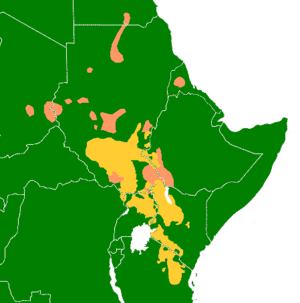Eastern Sudanic languages
| Eastern Sudanic | |
|---|---|
| (undemonstrated) | |
| Geographic distribution | Egypt, Sudan, South Sudan, Eritrea, Ethiopia, Kenya, Tanzania, Uganda, Congo (DRC) |
| Linguistic classification |
Nilo-Saharan?
|
| Subdivisions | |
| ISO 639-5 | sdv |
| Glottolog | None |
 Eastern Sudanic languages: * Group k (orange) * Group n (yellow) | |
In most classifications, the Eastern Sudanic languages are a group of nine families of languages that may constitute a branch of the Nilo-Saharan language family. Eastern Sudanic languages are spoken from southern Egypt to northern Tanzania.
Nubian (and possibly Meroitic) gives Eastern Sudanic some of the earliest written attestations of African languages. However, the largest branch by far is Nilotic, spread by extensive and comparatively recent conquests throughout East Africa. Before the spread of Nilotic, Eastern Sudanic was centered in present-day Sudan. The name "East Sudanic" refers to the eastern part of the region of Sudan where the country of Sudan is located, and contrasts with Central Sudanic and Western Sudanic (modern Mande, in the Niger–Congo family).
Lionel Bender (1980) proposes several Eastern Sudanic isoglosses (defining words), such as *kutuk "mouth", *(ko)TVS-(Vg) "three", and *ku-lug-ut or *kVl(t) "fish".
In older classifications, such as that of Meinhof (1911), the term was used for the eastern Sudanic languages, largely equivalent to modern Nilo-Saharan sans Nilotic, which is the largest constituent of modern Eastern Sudanic.
Glottolog (2013) does not accept that a relationship has been demonstrated between any of the nine families of Eastern Sudanic, nor their connection to a broader Nilo-Saharan phylum.
Internal classification
There are two recent classifications of East Sudanic languages.
Bender 2000
Bender assigns the languages into two branches, depending on whether the 1sg pronoun ("I") has a /k/ or an /n/:
| Eastern Sudanic |
| |||||||||||||||||||||||||||||||||
Starostin 2015
Starostin, using lexicostatistics, finds strong support for Bender's Northern branch, but none for the Southern branch.[1] Eastern Sudanic as a whole is rated a probable working model, pending proper comparative work, while the relationship between Nubian, Tama, and Nara is beyond reasonable doubt.
| Eastern Sudanic |
| ||||||||||||||||||||||||||||||||||||
Nyima is not part of the northern group, though it appears to be closest to it. (For one thing, its pronouns align well with the northern (Astaboran) branches.) Surmic, Nilotic, and Temein share a number of similarities, including in their pronouns, but not enough to warrant classifying them together in opposition to Astaboran without proper comparative work. Jebel and Daju also share many similarities with Surma and Nilotic, though their pronominal systems are closer to Astaboran.
Inclusion of Kuliak and Berta is not supported. Similarities with Kuliak may be due to both being Nilo-Saharan families, whereas Berta and Jebel form a sprachbund.
References
- ↑ George Starostin (2015) The Eastern Sudanic hypothesis tested through lexicostatistics: current state of affairs (Draft 1.0)
Bibliography
- Bender, M. Lionel. 2000. "Nilo-Saharan". In: Bernd Heine and Derek Nurse (eds.), African Languages: An Introduction. Cambridge University Press.
- Bender, M. Lionel. 1981. "Some Nilo-Saharan isoglosses". In: Thilo Schadeberg, M. L. Bender (eds.), Nilo-Saharan: Proceedings of the First Nilo-Saharan Linguistics Colloquium, Leiden, Sept. 8-10, 1980. Dordrecht: Foris Publications.
- Temein languages (Roger Blench, 2007).
- Starostin, George (2015). Языки Африки. Опыт построения лексикостатистической классификации. Том II. Восточносуданские языки [The Languages of Africa. The experience of building a lexiostatistical classification.] (in Russian). II: The Eastern Sudanic Languages. Moscow: Languages of Slavic culture. ISBN 9785457890718.